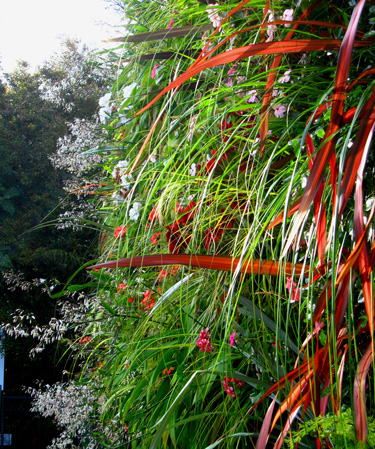Up the wall
Vertical gardens add to the beauty of our urban areas. And the equipment and knowledge of how to make them is available be they multi-storey vertical gardens or smaller domestic green walls. Liz Light talks to the experts.
Vertical gardens, also called hanging gardens and green walls, have been around for a long time. The Hanging Gardens of Babylon, in 600 BC, are a famous early version and ivy and other creepers have been gracing walls and houses for centuries.
What is changing is the recognition of the need for greenery and gardens in urban areas. People want plants in their lives and want gardens to enjoy regardless of their living and working situations.
Urbanisation, apartment living and infill housing have led to a physical lack of space for traditional gardens so home gardeners, businesses, and councils are turning to vertical gardens. This is a global trend and in places, such as Singapore and Paris, councils are legislating green walls and green spaces into development plans.
Vertical gardens are appearing in all sorts of places in New Zealand. The biggest so far, but there are more on developers’ drawing boards, is the Atrium on Takutai in Auckland’s Britomart Place.
Two huge walls, each 60-square-metres face each other across a central atrium. The initial reaction, when one walks into the Atrium, is the absolute wow factor of this eco art but, besides that, the plants improve the air quality, add to insulation and enhance acoustics in what would otherwise be a noisy glass-clad area. It has been there for five years, and still looks fabulous, proving the technology behind it, and maintenance of it, works well.
Natural Habitats designed and created the Atrium. Sam Dixon, green technology specialist, explains that the company uses a media that simulates soil (clays and synthetic and organic material) and this is held in a metal mesh cage about the width of a mattress with permeable geotextile cloth holding the media in place. The cage is rectangular (1 X 2 metres), and any number of them can be placed together making a wall garden as big as the customer wants.
The garden is fed by an automatic hydroponic-style irrigation system. Dixon says that, just like all gardens, vertical gardens need maintaining and Natural Habitats tends the Atrium walls fortnightly, removing dead leaves, replacing plants that aren’t doing well and looking for the usual culprits of mealy bugs, fungus, scale and aphids.
Leigh Nicholson, owner of Hanging Gardens, uses a completely different system but one that works equally well, particularly on smaller green walls. Nicholson lives in Howick, Auckland, and her garden was too small so, in 2012, she decided to extend it upwards with a green wall. She couldn’t find anything suitable in the shops, so she worked on the concept of hanging pockets. What she devised, through trial and error, has become a successful hanging garden system. “The outer material is like shade cloth but it’s permeable and it breathes. This comes in two shapes with three pockets hanging vertically or three pockets hanging horizontally. These are suspended by a strong stainless steel rod and can be attached to the wall by hooks, screws or nails. The gardens can be as big or as small as the customer needs when individual units are hung next to each other.
“The point of difference between this and other similar systems is that Hanging Gardens uses a felt inner, 30 centimetres wide and 22 centimetres deep. The plants grow in these inners which are placed in the pockets. They can be removed and put in different pocket – think of chequered garden art - and plants, such as bulbs and other annuals, can be removed when they are finished and stowed in a corner until they are ready the following year,” she says.
“They make terrific vegetable gardens, too. Plants such as peas, beans and strawberries are born to hang.”
Nicholson’s Hanging Gardens can be scaled-up to cover big walls and Natural Habitats’ system can be scaled-down for domestic gardens but it’s fair to say that, because of the technology and price factor, Natural Habitats is the choice for bigger commercial, corporate, Council and apartment projects. The simplicity and price-point of Hanging Gardens and similar products available in garden centres makes it more suited to domestic projects.
Vertical gardens in urban areas add visual, psychological and ecological value. Plants make people happy and green life matters. Thankfully, creating green walls is easier than ever and this trend is here to stay.
What to think about
- Size and affordability. Most systems are modular so can be as big as you like. Get the square metre cost.
- Water. Outside - Do you want to water with the garden hose or have an automatic irrigation system? Inside - Think about wall waterproofing and drip trays and watering can or an irrigation system?
- Light. Inside - Is there enough natural light or is additional lighting required? Outside - Is it north-facing in full sun or south-facing with no sun or something between?
- Plant species. As in any garden, the selection of plants relates to light, wind, temperature and personal preference. You can’t plant trees though some shrubs work well.
. New Zealand natives are often excellent; flaxes, hebes, coprosmas, do well in sunny situations. Ferns and some grasses prefer shade.
. Epiphytes grow in trees; a wall is just another tree for them. But bromeliads don’t take frosts.
. Exotic flowering plants, such as agapanthus, gerberas and clivia, have attractive leaves when they are not flowering.
. Annuals and vegetables can be planted for the season, just as if they were in a conventional garden.
6-Sep-2016





